The eye is a dynamic dioptric system able to adjust its refractometric capabilities according to the variations in distance of the point of focus:
from infinity = parallel rays
to reading = diverging rays
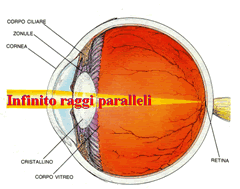
Renato
Meduri
Chair of the
Department of Optical Physiopathology
University of
Bologna
The eye is a dynamic dioptric system able to adjust its
refractometric capabilities according to the variations in distance of the point
of focus:
from infinity =
parallel rays
to reading = diverging rays
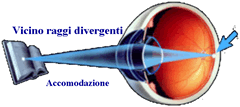 After the image is
captured, accommodation allows visual information in the best conditions,
through focus of the optical image on the retina, according to spatial
dimensions (depth).
After the image is
captured, accommodation allows visual information in the best conditions,
through focus of the optical image on the retina, according to spatial
dimensions (depth).
The first valid description and explanation of this phenomenon was formulated by German doctor Herman von Helmholtz, in the middle of the XIX century, in one of his publication on optical physiology, Handbuchs der physiologischen Optik. With changes in the curb of the crystal lens caused by the state of contraction of the ciliary muscles, he concluded on the mechanism of the phenomenon. It was a brilliant observation given that it was done with means of research that were decidedly modest, and that it is still fully valid today.
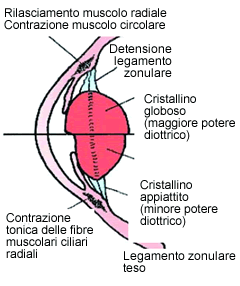 The relaxation of
the ciliary muscles induce an increase of the sphincter's diameter, bringing
tension to the ligaments of the zonules, which exert a traction on the middle of
the lens, and a flatness of anterior and posterior areas. The lens' dioptric
capabilities are at their lowest. This situation is appropriate for an
emmetropic eye when distance rays hit the retina that has focused (for man this
means over six meters).
The relaxation of
the ciliary muscles induce an increase of the sphincter's diameter, bringing
tension to the ligaments of the zonules, which exert a traction on the middle of
the lens, and a flatness of anterior and posterior areas. The lens' dioptric
capabilities are at their lowest. This situation is appropriate for an
emmetropic eye when distance rays hit the retina that has focused (for man this
means over six meters).
And vice-versa, the contraction of ciliary muscles corresponds to the state of accommodation to see at close range: this means the crystalline lens absorbs maximum reflective powers.
This accommodation capability does not remain intact throughout life. The emmetropic eye (that is not myopic, hypermetropic or astigmatic) in youth reaches a power over 10, then it tends to progressively reduce: at 40 years of age, it is at 3 1/2; at 45, 2 1/2; at 50, 1 1/2, and at 55, 1/2.
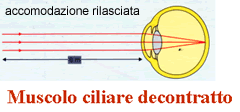
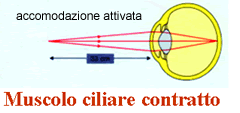
That is why at 25 years of age,
the next level is above 25 cm, increasing its distance until the age of 60, age
at which is 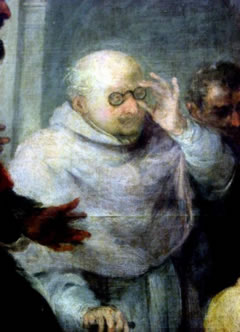 lost all
residue of accommodating function in the emmetropic eye. Since to go from infinite vision (parallel
rays) to close vision (diverging rays), like in reading, it is necessary to have
an accommodation level of 3 1/2. It is clear that at 45 years of age, there are
potential difficulties for seeing at close range, and these difficulties will
increase over the years.
lost all
residue of accommodating function in the emmetropic eye. Since to go from infinite vision (parallel
rays) to close vision (diverging rays), like in reading, it is necessary to have
an accommodation level of 3 1/2. It is clear that at 45 years of age, there are
potential difficulties for seeing at close range, and these difficulties will
increase over the years.
The eclectic school founded in the first century AC by Agatino Da Sparta, a school which tended to choose the most significant notions from various theories, found in Galeno a distinguished representative. Galeno described presbyopia and believed it was caused by the shrinking of cornea in old age, becoming rarefied according to the state of mind. Presbyopia later was discussed by Merculiar, doctor in the years 1500, in a voluminous and confused chapter, which included all pathologies relating to visual impairment.
Increase in the crystalline lens
In fact, this phenomenon called
presbyopia is not a disease, but simply the consequence of the continuous growth
of the crystalline lens. In the newborn, the shape of the crystalline lens is
almost spheric. There are no differences between the curves of the anterior and
posterior areas. The diameter is of 6-8 mm in the newborn, and 9-11 in the
adult. The thickness is 3,7 mm in the newborn, and 4,5-5 in the adult.
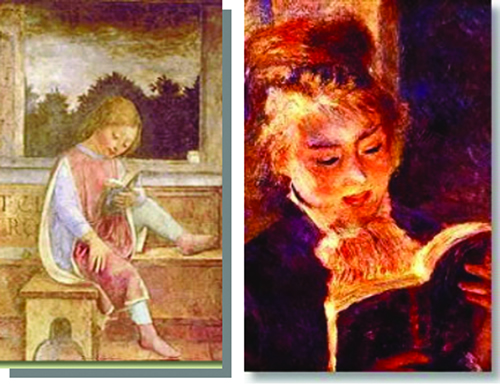 The weight
and volume are subjected to obvious increase from the time of birth to old age.
From a weight of 65 mg and 64 mm cubic volume, it reaches 230 mg and 213 mm
cubic in old age.
The weight
and volume are subjected to obvious increase from the time of birth to old age.
From a weight of 65 mg and 64 mm cubic volume, it reaches 230 mg and 213 mm
cubic in old age.
This increase in diameter and volume of the crystalline
lens brings it closer and closer to the ciliary muscles, reducing sensitivity to
its contraction and relaxation.
Aside from this, the proteins inside the crystalline lens become increasingly more rigid (like proteins in vessels, in articulations, etc.), creating less crystalline plasticity, which means a slower and more difficult process when changing shape, or focusing.
How presbyopia can be corrected
Following the discovery and making
of negative and positive lens thanks to the work of Antonio Manzini (1660),
positive lens began to be used to compensate difficulties in close vision. Even
today, positive lens represent the basic solution to correct
presbyopia.
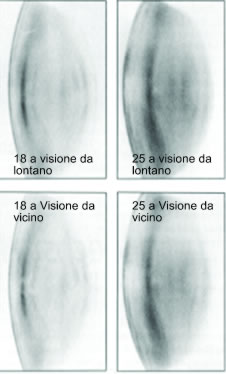 Things have
changed. It is now possible to use lenses that are particularly comfortable,
allowing a clear close up vision as well as middle range distances, ideal for
working in the office. For people who need to see up close, as well as in middle
and far range distances, progressive lenses may be used. These lenses modify the
refraction rate from up to down, allowing, with small adjustments in the
positions of the eyes, a good vision in all distances. For those who do not wish
to have glasses, it is possible to use contact lenses available today even in
progressive version. For those who do not wish to have contact lenses, the
problem can be resolved with refractive surgery which allows one eye to be made
myopic at 2 diopters and 1/2, adapting to close vision, and the other eye
emmetropic, adapted for distance vision. This is called monovision and, contrary
to what we may think, it is considered to be comfortable, and prosthesis are no
longer necessary.
Things have
changed. It is now possible to use lenses that are particularly comfortable,
allowing a clear close up vision as well as middle range distances, ideal for
working in the office. For people who need to see up close, as well as in middle
and far range distances, progressive lenses may be used. These lenses modify the
refraction rate from up to down, allowing, with small adjustments in the
positions of the eyes, a good vision in all distances. For those who do not wish
to have glasses, it is possible to use contact lenses available today even in
progressive version. For those who do not wish to have contact lenses, the
problem can be resolved with refractive surgery which allows one eye to be made
myopic at 2 diopters and 1/2, adapting to close vision, and the other eye
emmetropic, adapted for distance vision. This is called monovision and, contrary
to what we may think, it is considered to be comfortable, and prosthesis are no
longer necessary.
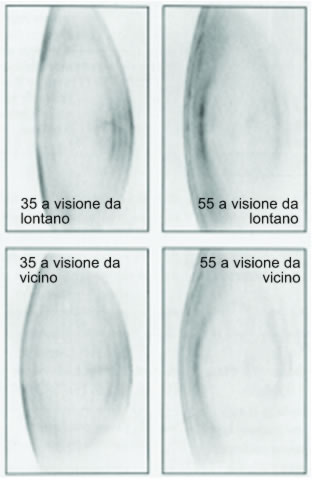 Good news
for those who need to have cataract surgery: there are multifocal lenses and
accommodative lenses, which are artificial crystalline lenses allowing the
person who has had cataract surgery to have a good vision up close and in
distances. However, they are crystalline lenses which require careful selection
by patients, and their cost is clearly superior to ordinary artificial
crystalline lenses.
Good news
for those who need to have cataract surgery: there are multifocal lenses and
accommodative lenses, which are artificial crystalline lenses allowing the
person who has had cataract surgery to have a good vision up close and in
distances. However, they are crystalline lenses which require careful selection
by patients, and their cost is clearly superior to ordinary artificial
crystalline lenses.
In the future, but not yet clinically applicable: after a graft of the internal portion of the crystal lens with its envelope, putting in a substance of gelatinous consistency would recreate a crystalline lens a lot similar to the crystalline of youth.
Lastly, and this is to correct a
wildly spread belief: use of sight for prolonged periods postpones the
manifestation of presbyopia and does not hurt the eyes.